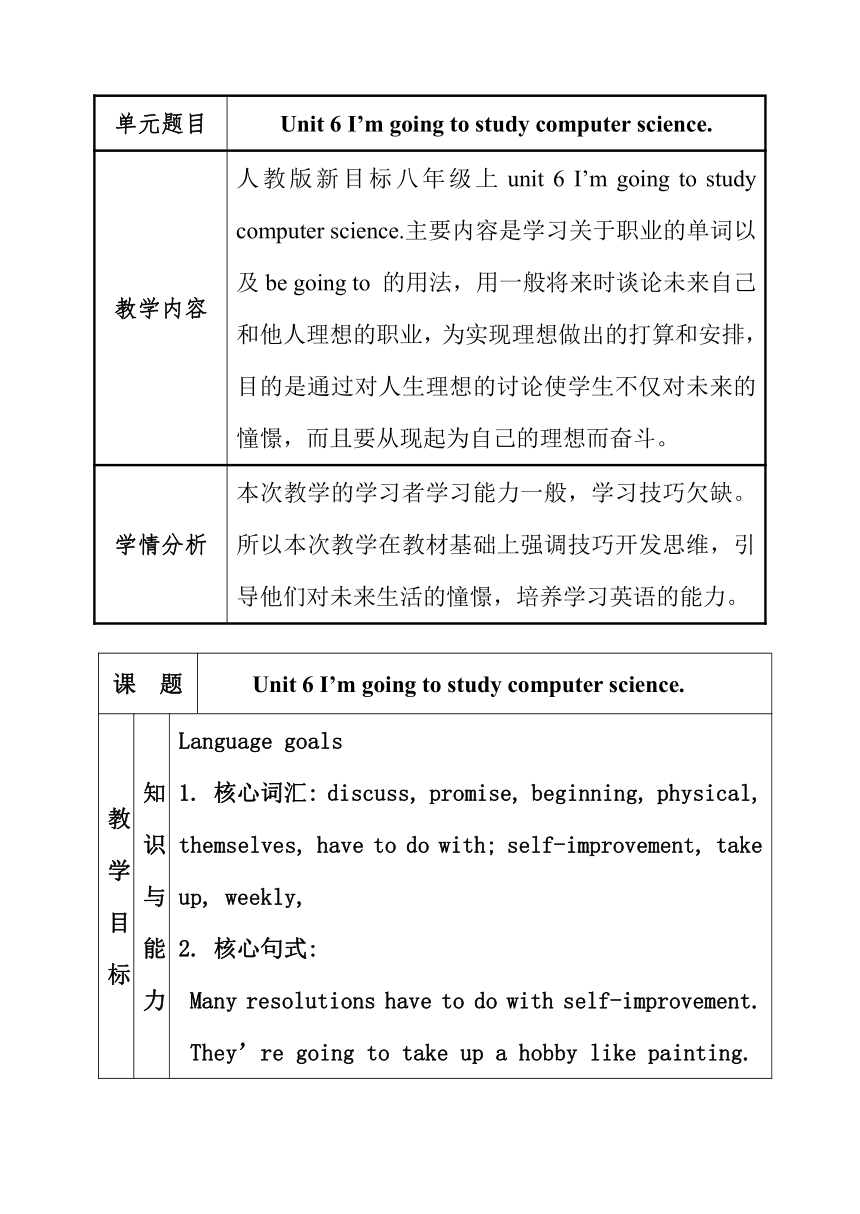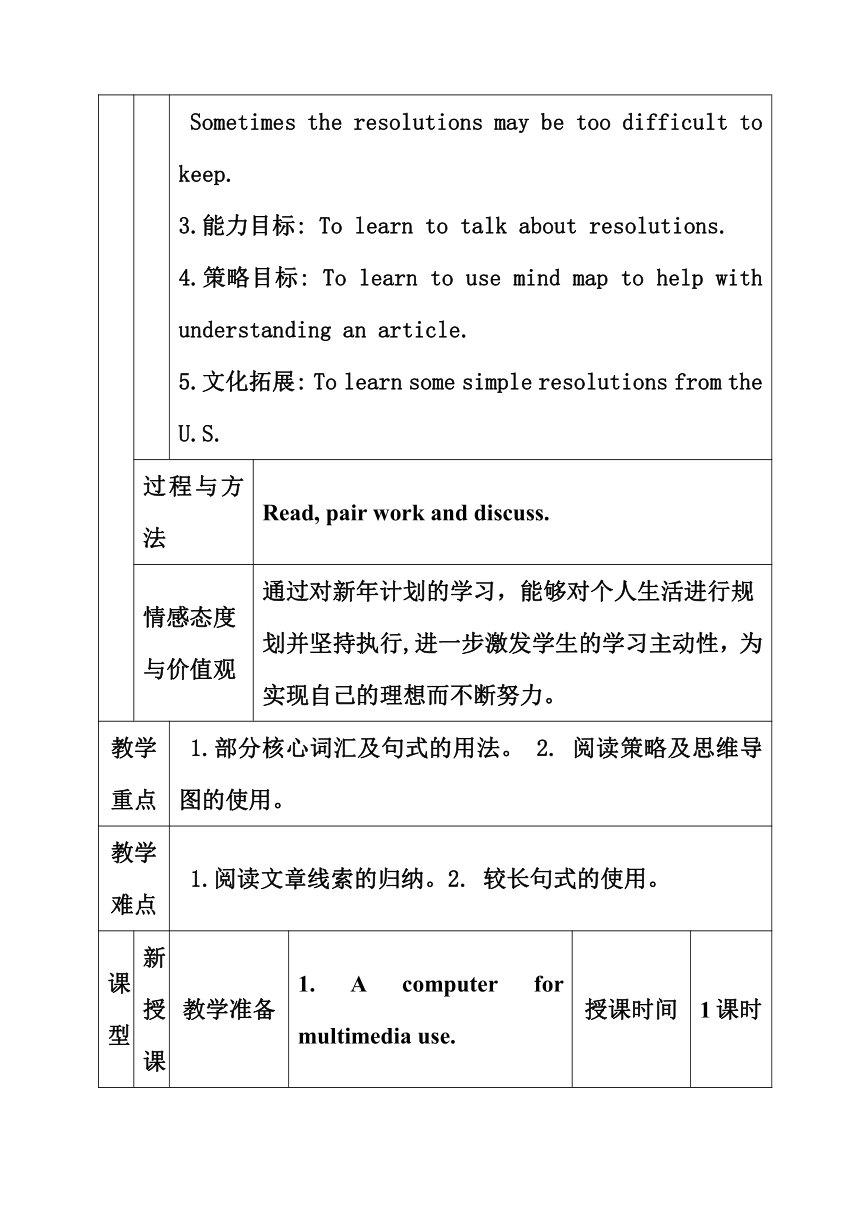人教版八年级上册Unit 6 I'm going to study computer science.SectionB 2a-2e 教案(表格式)
文档属性
| 名称 | 人教版八年级上册Unit 6 I'm going to study computer science.SectionB 2a-2e 教案(表格式) |  | |
| 格式 | doc | ||
| 文件大小 | 40.0KB | ||
| 资源类型 | 教案 | ||
| 版本资源 | 人教新目标(Go for it)版 | ||
| 科目 | 英语 | ||
| 更新时间 | 2022-11-15 20:06:55 | ||
图片预览


文档简介
单元题目 Unit 6 I’m going to study computer science.
教学内容 人教版新目标八年级上unit 6 I’m going to study computer science.主要内容是学习关于职业的单词以及be going to 的用法,用一般将来时谈论未来自己和他人理想的职业,为实现理想做出的打算和安排,目的是通过对人生理想的讨论使学生不仅对未来的憧憬,而且要从现起为自己的理想而奋斗。
学情分析 本次教学的学习者学习能力一般,学习技巧欠缺。所以本次教学在教材基础上强调技巧开发思维,引导他们对未来生活的憧憬,培养学习英语的能力。
课 题 Unit 6 I’m going to study computer science.
教学目标 知识与能力 Language goals1. 核心词汇: discuss, promise, beginning, physical, themselves, have to do with; self-improvement, take up, weekly, 2. 核心句式: Many resolutions have to do with self-improvement. They’re going to take up a hobby like painting. Sometimes the resolutions may be too difficult to keep.3.能力目标: To learn to talk about resolutions.4.策略目标: To learn to use mind map to help with understanding an article.5.文化拓展: To learn some simple resolutions from the U.S.
过程与方法 Read, pair work and discuss.
情感态度与价值观 通过对新年计划的学习,能够对个人生活进行规划并坚持执行,进一步激发学生的学习主动性,为实现自己的理想而不断努力。
教学重点 1.部分核心词汇及句式的用法。 2. 阅读策略及思维导图的使用。
教学难点 1.阅读文章线索的归纳。2. 较长句式的使用。
课型 新授课 教学准备 1. A computer for multimedia use. 授课时间 1课时
教 学 设 计
Step 1: Greeting and leading-in. Work in groups. Make a list of resolutions and how you are going to make them work. Then discuss with your group. Video. Ask Ss the question: Which word appears more times Resolutions (6 times).Step 2: Presentation Ss scan the passage fast and answer the two questions: Did you make any resolutions last year Were you able to keep them Why or why not …Step 3: 1.Ss read paragraph 1 again and form the Ss a mind map clue of Para 1. Then 4 questions: What is a resolution When do people usually make resolutions Why do people usually make resolutions How can people remember their resolutions 2. Ss read paragraph 2 again and form the Ss a mind map clue of Para 2. Then 1 question: How many kinds of resolutions does the write talk about 2)Ss read paragraph 3 again and form the Ss a mind map clue of Para 3. Then 2 questions: Why do you think resolutions may be difficult to keep Do you think the best resolution is to have no resolutions why or why not Step 4: Oral practice.Step 5: Discussion and summary.
教学内容 人教版新目标八年级上unit 6 I’m going to study computer science.主要内容是学习关于职业的单词以及be going to 的用法,用一般将来时谈论未来自己和他人理想的职业,为实现理想做出的打算和安排,目的是通过对人生理想的讨论使学生不仅对未来的憧憬,而且要从现起为自己的理想而奋斗。
学情分析 本次教学的学习者学习能力一般,学习技巧欠缺。所以本次教学在教材基础上强调技巧开发思维,引导他们对未来生活的憧憬,培养学习英语的能力。
课 题 Unit 6 I’m going to study computer science.
教学目标 知识与能力 Language goals1. 核心词汇: discuss, promise, beginning, physical, themselves, have to do with; self-improvement, take up, weekly, 2. 核心句式: Many resolutions have to do with self-improvement. They’re going to take up a hobby like painting. Sometimes the resolutions may be too difficult to keep.3.能力目标: To learn to talk about resolutions.4.策略目标: To learn to use mind map to help with understanding an article.5.文化拓展: To learn some simple resolutions from the U.S.
过程与方法 Read, pair work and discuss.
情感态度与价值观 通过对新年计划的学习,能够对个人生活进行规划并坚持执行,进一步激发学生的学习主动性,为实现自己的理想而不断努力。
教学重点 1.部分核心词汇及句式的用法。 2. 阅读策略及思维导图的使用。
教学难点 1.阅读文章线索的归纳。2. 较长句式的使用。
课型 新授课 教学准备 1. A computer for multimedia use. 授课时间 1课时
教 学 设 计
Step 1: Greeting and leading-in. Work in groups. Make a list of resolutions and how you are going to make them work. Then discuss with your group. Video. Ask Ss the question: Which word appears more times Resolutions (6 times).Step 2: Presentation Ss scan the passage fast and answer the two questions: Did you make any resolutions last year Were you able to keep them Why or why not …Step 3: 1.Ss read paragraph 1 again and form the Ss a mind map clue of Para 1. Then 4 questions: What is a resolution When do people usually make resolutions Why do people usually make resolutions How can people remember their resolutions 2. Ss read paragraph 2 again and form the Ss a mind map clue of Para 2. Then 1 question: How many kinds of resolutions does the write talk about 2)Ss read paragraph 3 again and form the Ss a mind map clue of Para 3. Then 2 questions: Why do you think resolutions may be difficult to keep Do you think the best resolution is to have no resolutions why or why not Step 4: Oral practice.Step 5: Discussion and summary.
同课章节目录
- Unit 1 Where did you go on vacation?
- Section A
- Section B
- Unit 2 How often do you exercise?
- Section A
- Section B
- Unit 3 I'm more outgoing than my sister.
- Section A
- Section B
- Unit 4 What's the best movie theater?
- Section A
- Section B
- Unit 5 Do you want to watch a game show?
- Section A
- Section B
- Unit 6 I'm going to study computer science.
- Section A
- Section B
- Unit 7 Will people have robots?
- Section A
- Section B
- Unit 8 How do you make a banana milk shake?
- Section A
- Section B
- Unit 9 Can you come to my party?
- Section A
- Section B
- Unit 10 If you go to the party, you'll have a grea
- Section A
- Section B
